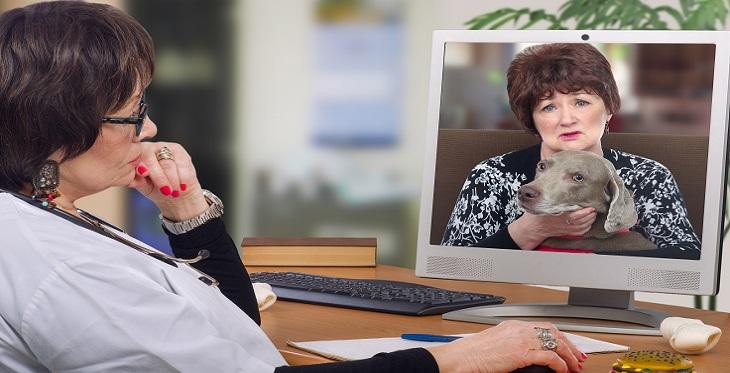
From Dr. Steven Hansen’s Arizona Humane Society office, you may have heard a sigh of relief when Arizona Gov. Katie Hobbs signed Senate Bill 1053 into law on May 9. Beginning in August, veterinarians licensed in the state will legally be able to provide veterinary care through telemedicine, a care alternative many have become accustomed to on the human side of healthcare.
Currently, there’s a six-week waiting list for pet owners who need the Humane Society’s subsidized services at their clinics in Maricopa County. Bringing telemedicine into the picture will make a difference.
“We know this is going to increase access to care,” said Hansen, Arizona Humane Society president and CEO. “There is a lack of veterinary access in Arizona. In Southwest Phoenix there is a severe veterinary desert. From our prospective we envision this bill will allow us to leverage telemedicine to manage cases and free up appointments to those who really need care in underserved areas of Maricopa County, as well as our mobile clinics that serve native lands.”
Between Hansen and Dr. Tina Tran, an Associate Professor of Practice and Clinical Relations Lead Veterinarian at the University of Arizona College of Veterinary Medicine, the word triage comes up often to describe how telemedicine can be used in a veterinary practice.
For the Humane Society care currently starts with a phone call from a pet owner concerned about their pet’s health. In August, when the law is officially in place, the phone call will help create a medical record for the patient, but rather than immediately place the pet on the waiting list, a telemedicine appointment will be scheduled.
Hansen said it’s too early to know if a platform will be used, but most likely the Humane Society wants to meet pet owners where they are either on the phone, through FaceTime, or maybe Zoom. This is when a triage of sorts takes place, listening to the pet owner describe the problem, and having the veterinarian decide if what’s before them is a simple prescription or easy remedy administered by the pet owner, an emergency that requires the pet be brought in immediately, or a non-emergency issue that requires an in-person appointment.
“We do not have enough veterinarians in Arizona, especially those serving underserved families. It’s created a double whammy to those communities,” Hansen said.
Hansen added that virtual veterinary care will make a difference, not only decreasing the Arizona Humane Society’s waiting list, but also the number of pets surrendered because owners can’t access the care needed. The result may be relief of over-crowded shelters throughout the state.
Tran said some of her peers are leery of introducing telemedicine into their practices, but she likes to remind them that tele-triage has been part of veterinary care for years, such as poison control hotlines where pet owners call with concerns with the end result being reassured their pet is fine or told they need to immediately head to the nearest emergency animal hospital.
In human telemedicine’s early days, and even during Covid-19, doctors were concerned about removing the in-person aspect of healthcare. Tran said the same is true for veterinarians concerned about establishing the veterinarian-client-patient relationship without an in-person examination.
While COVID-19 also pushed veterinary medicine profession toward telemedicine and remote communication methods, Tran said having this new law in place will help veterinary medicine potentially address some of its biggest challenges – primarily the shortage of veterinarians in Arizona.
In August, the University of Arizona College of Veterinary Medicine graduates its first class of 23 brand new veterinarians. They enter the Arizona workforce having done a majority of their rotations at veterinarian practices during the pandemic and understand the benefits of veterinary virtual care.
"We had, I guess, the good fortune of knowing only what it was like to work under Covid,” Trans said of her students.
At the start of the lockdown, then-Gov. Doug Ducey passed an executive order allowing telemedicine for human medical practices and veterinary practices.
“As challenging as Covid has been, there have been some real benefits to veterinary medicine to push us in our direction; that quite honestly, the profession for the most part, has been kind of dragging its feet on,” Tran said.
“We don’t have enough veterinarians to serve all the animals. ... I know there are many brick-and-mortar veterinary practices struggling to find veterinarians and technicians to work for them. And there are many qualified long-time veterinarians who no longer want to be in a traditional practice but might like to work remotely.”
Other concerns about telemedicine that Tran has heard from her peers: “If I don’t have that animal in front of me, how do I know that that owner has an animal? How do I know that when I prescribe two weeks of antibiotics that it's going to go to the cat that they told me about?”
“Who's going to ask for two weeks of antibiotics if they don't have an animal that needs it? I mean, yeah, there's probably some people that for whatever reason would do that. But most people need help for their animal, and that's why they're calling or texting or zooming with you,” Tran said.
According to Mark Cushing, founder and CEO of the Animal Policy Group, Telemedicine is just one part of the solution. “It's an inevitability, considering the changing landscape of pet ownership. Millennials and Gen Z now own half of the pets, and they're ready to embrace new ways of caring for their furry companions. We can't ask them to turn off their progress."
Cushing’s policy organization joined with the Arizona Farm Bureau, Arizona Humane Society, Southern Arizona Humane Society, Veterinary Virtual Care Association, ASPCA, and PetSmart Charities to advocate for the new law.
“The number of veterinarians isn’t keeping up with the number of pets,” Cushing said. “Until that changes, telemedicine is an option a pet owner and veterinarian can choose together.”


